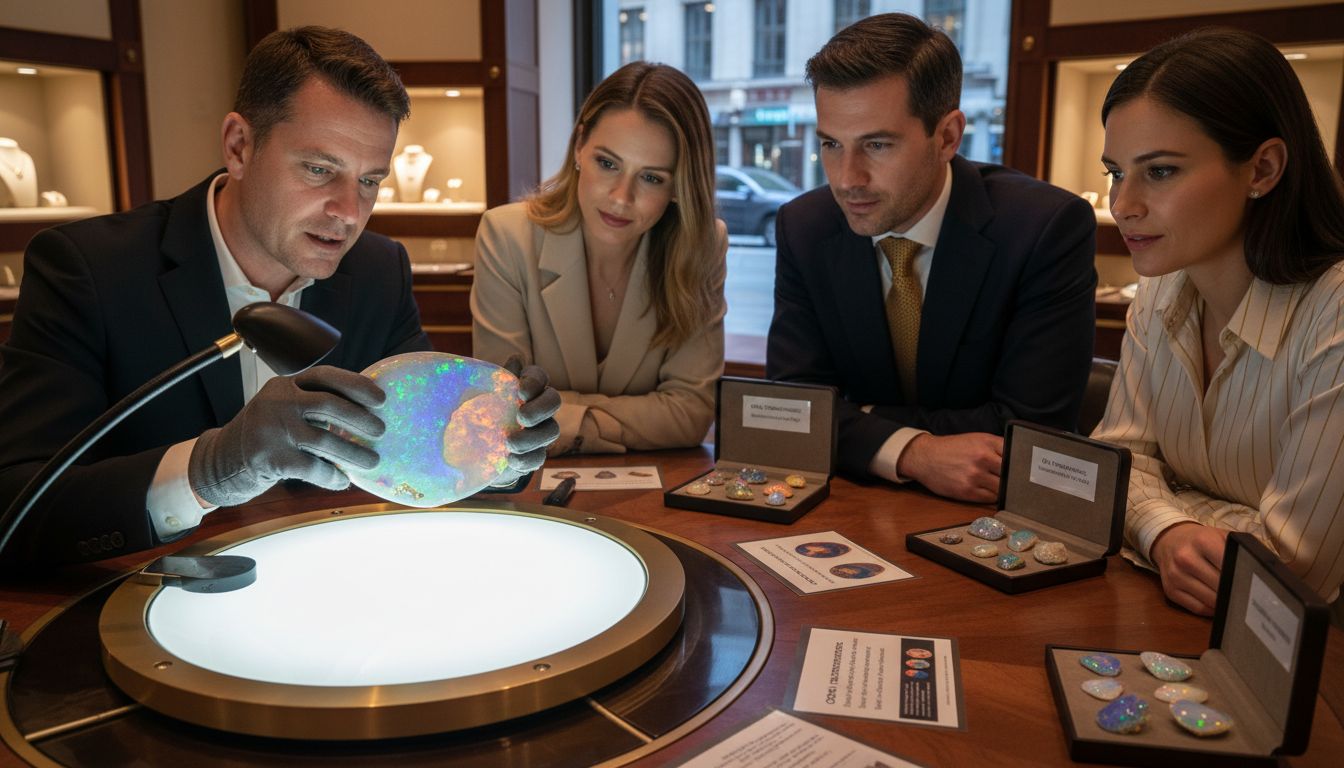Opal Opacity Explained: Guide for Gemstone Buyers
Posted by AOD on 23rd Nov 2025
Opal Opacity Explained: Guide for Gemstone Buyers

Over 70 percent of American gemstone collectors say that understanding opal opacity is crucial when choosing a stone for their collections. This property not only determines how brilliant an opal appears but also plays a key role in its overall value and desirability. By learning how light interacts with different types of opals, buyers and enthusiasts can better recognize rare finds and appreciate the unique beauty that each gemstone offers.
Table of Contents
- Defining Opal Opacity And Its Importance
- Types Of Opal Opacity And Key Variations
- Factors Influencing Opal Clarity And Transparency
- How Opacity Affects Value And Appearance
- Guidelines For Assessing Opal Opacity
Key Takeaways
| Point | Details |
|---|---|
| Opal Opacity Definition | Opal opacity defines the light transmission levels, impacting visual properties and market value. |
| Types of Opal Opacity | Opals are classified into transparent, translucent, and opaque categories, each affecting desirability among collectors. |
| Factors Influencing Clarity | Clarity is influenced by silica sphere arrangement, inclusions, structural irregularities, and water content, affecting light transmission. |
| Value Assessment | The value of opals correlates with their opacity; transparent opals tend to command higher prices due to more vibrant color displays. |
Defining Opal Opacity and Its Importance
Opal opacity is a critical characteristic that defines how much light passes through a gemstone, ranging from completely transparent to fully opaque. According to Opal Academy, this quality significantly influences the gem’s aesthetic appeal and market value. Transparency directly impacts an opal’s visual properties, determining how vibrant its play-of-color appears.
The spectrum of opal opacity includes several distinct classifications. As Gem Society explains, opals can be categorized into transparency levels that dramatically affect their desirability among collectors:
- Transparent Opals: Allow substantial light passage, showcasing vivid internal color patterns
- Translucent Opals: Permit partial light transmission with some visual diffusion
- Opaque Opals: Block light completely, presenting a more solid color appearance
Understanding these opacity variations helps buyers make informed decisions.
 Transparent crystal opals, for instance, often command higher prices because their exceptional light transmission enhances the stone’s natural color play and internal fire. Professional gemstone collectors and jewelry designers carefully evaluate an opal’s opacity to assess its potential value and aesthetic potential. This nuanced assessment involves examining how light interacts with the stone’s internal structure, revealing its unique optical characteristics.
Transparent crystal opals, for instance, often command higher prices because their exceptional light transmission enhances the stone’s natural color play and internal fire. Professional gemstone collectors and jewelry designers carefully evaluate an opal’s opacity to assess its potential value and aesthetic potential. This nuanced assessment involves examining how light interacts with the stone’s internal structure, revealing its unique optical characteristics.
Types of Opal Opacity and Key Variations
Opals display a fascinating range of opacity types that significantly impact their visual appeal and market value. Opal Academy reveals three primary opacity classifications that gemstone enthusiasts should understand: transparent crystal opals, translucent white opals, and opaque black opals. Each type offers unique optical characteristics that distinguish it in the gemstone marketplace.
According to Gem Society, opal varieties are categorized based on their body color and transparency levels. These classifications help collectors and jewelry designers assess a gem’s quality and potential applications. The key opacity variations include:
![]()
- Transparent Crystal Opals: Highly prized for their exceptional light transmission and vivid internal color play
- Translucent White Opals: Softer, more diffused appearance with moderate light penetration
- Opaque Black Opals: Rich, intense coloration with no light passage, often considered the most valuable
Understanding these opacity variations requires careful examination of how light interacts with the stone’s internal structure. Professional gemologists evaluate factors like color intensity, light refraction, and internal fire to determine an opal’s true value.
Some collectors prefer the ethereal quality of crystal opals, while others appreciate the dramatic depth of black opals. For buyers seeking the most comprehensive guide to opal types, exploring these opacity nuances becomes crucial in making an informed purchasing decision.
Factors Influencing Opal Clarity and Transparency
Opal clarity is a complex interplay of multiple microscopic factors that determine the gem’s visual characteristics. Opal Academy reveals that the internal structure of opal, specifically the arrangement and size of silica spheres, plays a pivotal role in determining its transparency and light transmission. These microscopic variations create unique optical properties that distinguish one opal from another.
According to Gem Society, impurities and inclusions significantly impact an opal’s clarity and visual appeal. These microscopic elements can scatter light, reducing the gem’s brilliance and creating complex optical interactions. The key factors influencing opal clarity include:
- Silica Sphere Arrangement: Determines light refraction and color play
- Mineral Inclusions: Can create opacity or interrupt light transmission
- Structural Irregularities: Impact the gem’s overall transparency
- Water Content: Influences light diffusion and internal reflectivity
Professional gemologists meticulously assess these nuanced characteristics to determine an opal’s quality. Collectors seeking a deeper understanding of gem selection might find the comprehensive opal selection guide particularly helpful in navigating these intricate visual complexities. Understanding these microscopic factors transforms how buyers perceive and appreciate the remarkable optical dance within each unique opal specimen.
How Opacity Affects Value and Appearance
Opal value is intrinsically linked to its opacity, creating a complex relationship that fascinates gemstone collectors and jewelry designers. Opal Academy reveals that transparent opals, particularly crystal opals, often command higher prices due to their ability to showcase more vibrant play-of-color. This remarkable optical characteristic makes transparency a critical factor in determining an opal’s market desirability.
According to Gem Society, opaque opals like black opals can equally captivate collectors with their intense and striking color displays. The opacity creates a dramatic backdrop that enhances the gem’s internal fire and color variations. The key value considerations based on opacity include:
- Transparency Level: Directly impacts light interaction and visual brilliance
- Color Contrast: Darker backgrounds can intensify color play
- Light Transmission: Determines the gem’s internal optical performance
- Rarity: Some opacity types are more uncommon and collectible
Professional gem appraisers carefully evaluate these nuanced opacity characteristics to determine an opal’s true worth. For collectors seeking deeper insights into gem valuation, the comprehensive opal value guide offers an extensive exploration of how these subtle optical properties influence pricing and collector interest. Understanding opacity is more than a technical assessment - it’s about appreciating the unique visual story each opal tells.
Guidelines for Assessing Opal Opacity
Opal opacity assessment requires a systematic approach that combines visual examination and technical understanding. Opal Academy emphasizes the importance of carefully observing light transmission and internal clarity when evaluating a gemstone’s transparency. Professional gemologists use specialized techniques to determine the nuanced characteristics that define an opal’s optical performance.
According to Gem Society, examining an opal under various lighting conditions reveals critical insights into its opacity and quality. The key evaluation techniques include:
- Backlighting Test: Observe light penetration and internal color distribution
- Angle Examination: Rotate the stone to assess light interaction and color play
- Natural Light Inspection: Evaluate transparency in different environmental conditions
- Magnification Analysis: Inspect microscopic structures affecting opacity
For collectors seeking comprehensive guidance, the opal stone history and characteristics guide provides additional context for understanding these intricate assessment methods. Mastering these evaluation techniques transforms how buyers perceive and appreciate the complex optical properties of opals, turning a simple gemstone assessment into an art form of visual discovery.
Discover the Perfect Opal with Confidence
Understanding opal opacity is essential when selecting a gemstone that truly resonates with your style and collector’s goals. Buyers often struggle with assessing transparency, color play, and clarity, which can make choosing the right opal overwhelming. Our curated collection at Australian Opal Direct offers expertly sourced opals that highlight the full spectrum of opacity types from transparent crystal opals to rich opaque black opals, crafted to meet your highest expectations.

Explore our genuine Australian opals with detailed descriptions that illuminate each stone’s unique light interaction and rarity. Take advantage of our direct-miner relationships, free shipping, and custom jewelry services to own a priceless piece of Australia’s heritage. Start your journey toward owning an opal that tells a vibrant story by visiting the Australian Opal Direct homepage and dive deeper with our comprehensive opal selection guide. Your perfect gemstone awaits, and now is the time to experience the true brilliance of opal opacity.
Frequently Asked Questions
What is opal opacity and why is it important?
Opal opacity refers to how much light passes through a gemstone, ranging from transparent to opaque. It significantly impacts the gemstone’s aesthetic appeal and market value, as it affects the vibrancy of the opal’s play-of-color.
What are the different types of opal opacity?
Opal opacity can be classified into three main types: transparent, translucent, and opaque. Transparent opals allow substantial light, while translucent opals permit partial light transmission, and opaque opals block light completely, showcasing solid colors.
How does opal opacity affect its value?
Opal value is closely linked to opacity; transparent opals, particularly crystal types, tend to be more expensive due to their vibrant play-of-color. Opaque opals, such as black opals, can also be valuable because their opacity enhances color displays.
What factors influence the clarity and transparency of opals?
Factors affecting opal clarity include the arrangement and size of silica spheres, mineral inclusions, structural irregularities, and water content. These elements contribute to the gem’s visual characteristics and overall transparency.




